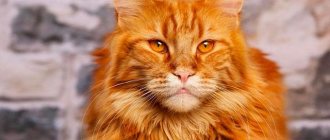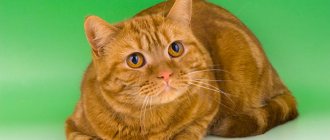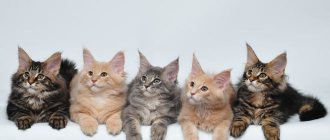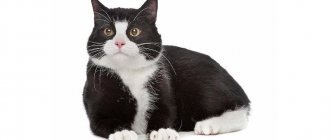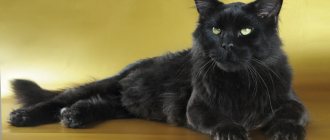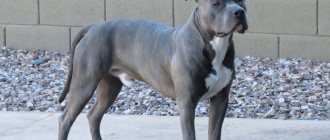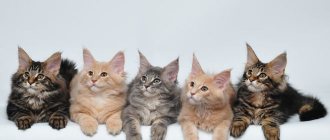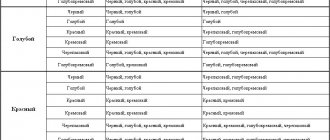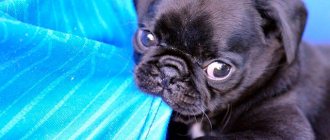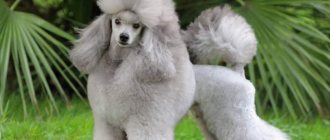Maines can be colored very differently, but genetically, like all other cats, the Maine Coon has only two colors: black and red. The remaining colors are variations on the theme of two natural colors, the result of the painstaking work of breeders. That is, if you have a red Maine Coon cat or a black Maine Coon solid cat, it means that you are the happy owner of a cat that carries the genetic code of the distant ancestors of the modern “raccoon” cat from Maine.
Any Maine Coon color is a combination of black and red pigments
However, for many novice Maine owners, the problem is the felinological terminology itself. What to do if you know only two cat colors, tabby and non-tabby, and your attention is offered to a black marbled or cream solid Maine Coon? Let's try to figure it out.
How would this be scientific?
The types of colors of Maine Coon cats in the unified international EMS system are assigned codes consisting of letters and numbers, each of which indicates a particular color characteristic:
- main color
| n | black |
| a | blue |
| d | red |
| e | cream |
| f | black turtle |
| g | blue cream turtle |
| s | silver or smoke (manifestation of one gene, but patterned individuals are called silver, and solid ones “smoky”) |
| w | white (may be due to the manifestation of different genes) |
- presence and type of white spots
| 01 | van (white individual with a small spot, spots of the main color) |
| 02 | harlequin (two thirds of the individual is white) |
| 03 | two-color or bicolor |
| 09 | with white (less than half white) |
- the presence of a pattern on the fur and its appearance
| 22 | marbled or classic tabby (“M” on the forehead and beautiful “butterflies” on the sides of the individual) |
| 23 | brindle tabby or mackerel (“M” on the forehead and stripes all over the body) |
| 24 | spotted (Maine Coons have torn tiger or merle) |
| 21 | agouti factor (recorded when it is clear that the animal is a tabby, but it is not clear what kind of pattern it is) |
| 11 | shaded (tabby on silver with a blurry pattern on the body) |
| 12 | chinchilla - black series of colors, cameo - red series (very strong silver, in which the animal looks almost white with a slight touch of the main tone, sometimes completely white) |
- eye color (not always indicated)
| 61 | blue - blue |
| 62 | yellow, golden - yellow, orange, golden, etc. |
| 63 | oddeyed - disagreement |
| 64 | green - green |
In terms of primary color, the following Maine Coon colors are allowed: black, white, red, blue, cream, cream-blue and tortoiseshell. Shades of chocolate and cinnamon are strictly prohibited for Maine Coons.
Recognized Maine Coon colors
The type of color depends on three parameters:
- coat color;
- absence/presence of drawing;
- spotting (taking into account the size and color of the spots).
The classic Maine Coon colors include only red (fawn) and black . Other known variants are the result of lightening/oxidation of the main pigment, which is associated with the genetics of a particular animal and the action of external factors.
Recognized Maine Coon colors are grouped into 5 groups:
- solid (monochrome or solid);
- tabby (with pattern);
- smoky;
- tortoiseshells;
- colors with white.
Recently, cats of two colors are considered the most popular - black tabby and red tabby tabby.
Solid
There are five approved Maine Coon solid colors, including black, white, red, cream and blue.
The breed standard determines that the color should be rich and deep, and the hairs should be intensively dyed along the entire length, starting from the root. The cat itself should also have a uniform color (without splashes of another color) from the head to the tip of the tail.
Important! The disadvantages of monochrome colors include: lightened undercoat, hairs of a different color on the body, residual (shadow) spots/stripes on the cat's head or body.
Tabby
If your Maine Coon is striped, it is a tabby color (the natural color of forest cats, according to felinologists) . Thin lines outline the cat's eyes, forming an "M" on the Maine Coon's forehead. Looking at an individual hair, you can see how light and dark zones alternate (alternation, called “agouti”).
There are four known tabby patterns:
- Mackerel tabby or brindle - parallel vertical stripes;
- Classic tabby or classic - wide spiral lines on the sides, similar to marble stains. The British call this pattern “blotched tabby”;
- Spotted tabby or spotted - the pattern resembles intermittent stripes scattered throughout the body;
- Ticked tabby or ticked - without obvious stripes/spots on the body, but with a pattern on the muzzle and an agouti-type body color. The coloring is characteristic of Abyssinian cats, which is why it is also called Abyssinian.
Since tabby is found in Maine Coons with different coat colors, the color of the stripes or the tip of the tail is considered decisive.
Tortoiseshells
This broad category includes colors with a random combination of colors, where, in turn, all colors are divided into two groups - with and without white.
Colors without the presence of white:
- tortoiseshell, tortie (turtle) - cream, red or black spots of varying clarity scattered throughout the body;
- brown patched tabby (brown spotted tabby or torbie) - like fallen autumn leaves, with patches of brown and red tabby;
- blue-cream (blue-cream) - muted cream and blue spots are distributed randomly over the body. The color is also called blue tortie (blue tortoise) and dilute tortie (dilute tortoise);
- blue patched tabby (blue spotted tabby) is a very calm color with zones of blue and cream tabby.
Colors that contain white:
- calico (chintz or calico) - a lot of white. In fact, the more white paint, the more pronounced the black and red spots appear. Large red spots are usually combined with tabbies, and black spots with solid colors;
- blue-cream and white (blue-cream with white) or tortoiseshell and white (tortoise shell with white) - appears in the form of small white “islands” on the body;
- dilute calico (diluted chintz) - with inclusions of uniform blue and cream (with tabby) spots;
- patched tabby and white (spotted tabby with white) - an arbitrary amount of white in the tabby areas.
Smoky and silver
The smoke color requires that the root of the hair be perfectly white (not gray like the usual solid Maine Coons) and the coat colored solid black or blue.
Such animals belong to two groups:
- black smoke - black fur with completely white roots;
- blue smoke (blue smoke) - blue wool with bleached roots.
Silver Maine Coons have white hair at the base and a tabby coat color . The percentage of white color determines the type of color:
- chinchilla - 1/8 of the tip of the hair is painted over;
- shaded - the hair is colored 25-30% in the main color;
- smoky - the hair is 50% shaded.
Shaded and smoky Maine Coons of cream/red color receive the addition of “cameo” when designating their color.
This is interesting! Smoky and silver cats look especially impressive in motion, when their fur shimmers and changes shade.
Colors with white markings
The classification of such colors depends on the size and location of the white spots on the Maine Coon’s body:
- locket - white spot (medallion) on the chest;
- mitted - white gloves (slippers) on paws;
- buttons - small white spots (buttons) on the body;
- bi-color - half white or bicolor;
- harlequin - white with several large colored spots or harlequin;
- tuxedo - white paws/chest (tuxedo). A little white on the head is allowed;
- van - completely white (except for the head and tail) or van.
Outlined white markings can complement any Maine Coon coloration. In this case, the phrase “and white” is added to the description of the main color.
Return to content
"Smoky" beauties
“Smoky” cats look very impressive, especially when their shiny, well-groomed fur sways and shimmers in the light. The smoky color is due to the fact that the root of each cat’s hair is white, and the end is colored, and with different intensities. For example, in a Maine Coon, black smoke has a strong base color.
In international coding, this sign is marked with the Latin letter S, which, depending on the interpretation, can mean smoke (smoke) or silver (silver). According to the degree of hair coloring, smokiness is divided into the following categories:
- regular smoke - half the hair is dyed;
- shaded smoke - a quarter of the hair is dyed;
- chinchilla – one-eighth of the hair is dyed.
color blue smoke
color red smoke
color black smoke
Exquisite Silver
The silver coon stands somewhat apart in this gradation. This is such a light coat color that it is very difficult to distinguish it from white, especially in childhood. A silver Maine Coon kitten is usually identified by the color of its iris: a white Maine most likely has blue eyes, and a silver Maine has green eyes. Over time, the silver coat darkens a little, and a pattern called “tabby” (discussed below) becomes more pronounced on it. Cats of this color are generally very attractive and unusual, but the so-called “marble on silver” looks especially elegant, when wide spiral stripes are run along the silvery fur, reminiscent of marble patterns.
color silver tabby
color tortoiseshell silver bicolor
color red silver
Color options
If we talk about haze, they have an uneven color.
Most often, the roots of their hair are completely white or lighter from the top. The light tone is especially visible when the cats are moving. Smoky kittens are very beautiful, but adult animals attract the eye and seem more mysterious. Those people who specialize in cat breeds divide smoky cats into several subspecies, distinguishing them by the degree of coloring. If we talk about standards, then smoky cats can include animals of any color. For example, you can find black smoke, and gray, and red, and tortoiseshell. In addition, lighter hazes are allowed, for example, blue or cream. The dominant gene Dilutor is responsible for pigmentation. And therefore, light-colored animals in the future will have a lighter base shade.
Depending on the degree of color, smoky Maine Coons can be divided into the following categories.
- Shaded cats have only ¼ of their hair colored.
- Chinchillas have 1/8 of their hair dyed.
- Smoky cats are cats whose fur is half colored.
- Black smoke. These cats are almost completely black. Only the roots of the wool are white.
- Blue smoke cats are blue in color, but the roots are completely white.
- Silver cats are born almost white. However, over time, the fur becomes silver. Their distinctive feature is their emerald eyes.
- Red smoke. Animals are born almost white, but over time they develop a red haze.
Bicolor or not bicolor?
The main color of the maine can be complemented by clearly defined white spots of different sizes. Some owners call any white-spotted cat “bicolor,” but this is not entirely true. White spots also have their own official names:
- “buttons” - small spots all over the body;
- “gloves” - white paw tips;
- “medallion” - a spot on the chest;
- “harlequin” - white background with large colored spots;
- "van" - predominantly white with color only on the head and tail;
- “tuxedo” (felinology does not formally use this definition, but it is widely used among cat owners) – white legs and chest, contrasting with the main color.
And bicolor is the official name of a color in which white and colored wool are present in a ratio of 50x50.
color black bicolor
color red bicolor
color blue bicolor
Bicolor individuals
Ticked
The ticked color is characteristic of animals of other breeds, but occasionally occurs in Maine Coons.
Other names are agouti or Abessinian color. Such pets are classified as tabby. Cats with this pattern are characterized by black parallel stripes on the upper part of the face. But there are no patterns on the body and there is only a single dark shade. Often this type of coloring is found in other breeds, is not recognized in Maine Coons and is not included in the classification of colors of this type of animal.
brindle tabby
This ticked color in Maine Coons is considered a wild color: the pet has vertical elongated stripes throughout the body. Parallel interrupted stripes are less common, but such a pattern is not considered defective and is recognized by the classification. Less commonly, peach-colored tri-colored tabbies are combined with small spots on the cat's ribs. The pattern is sometimes called "mackerel" due to its resemblance to the fish of the same name. The lighter the cat's coat, the more noticeable the tabby.
Painted cats
The coat pattern often found among Maines is called tabby or, if pronounced in English, tabby. Scientists claim that tabby is present in the genotype of all cats without exception - they inherited it from their wild forest ancestors. The pattern is obtained due to the fact that, under the influence of a certain gene, the color of cat hair is zoned. Simply put, this means that the hair is not monochrome, but striped, as can be seen upon closer inspection.
Depending on how the light and dark areas are located on an individual hair, one or another pattern is formed on the wool. Tabby is divided into various "patterns", for example:
- brindle color is continuous parallel stripes;
- spotted – intermittent stripes;
- classic - marble stains.
The latter looks best on a black Maine Coon; the black tabby Maine looks surprisingly noble.
tabby color merle
tabby brindle color
tabby color spotted
Elegant ticking
A type of pattern that is uncharacteristic for Maines is ticked. With this color, the entire mass of the coat consists of striped (ticked) hair in the absence of a pronounced pattern (its residual signs can be on the legs, chest and forehead). Ticking is more common among Abyssinian cats; Maine Coons with this color are very rare. These cats look very elegant, especially the black ticked one.
color silver ticked
color red ticked
color ticked
The charm of diversity
Tortoiseshell color is a good omen - many believe that multi-colored cats bring their owners good luck in all endeavors. This may not be true, but they definitely bring joy and aesthetic pleasure.
The pied Maine Coon, especially with “smoke,” is incredibly picturesque. And in this case, it is not so important whether it is a classic “tortoiseshell” (randomly scattered spots of any color except white), or spotted brown, reminiscent of autumn foliage in color, or creamy blue tortoiseshell, combining delicate pastel shades. Without exception, all the “turtles” are magnificent!
tortoiseshell color
smoky tortoiseshell color
color tortoiseshell bicolor
Types of colors
The Maine Coon cat breed comes in a wide range of shades. Among the animals there are individuals with uniform coats, with spots and stripes of unusual shades. There are classic colors that are present in the EMS system with codes and are designated by the letter n. Traditionally it is believed that natural colors are red and black. The remaining shades appeared in the process of mixing the main range. White coloring is considered a complete absence of color. This is an expensive breed that requires careful personal care: the pet must be vaccinated, shown to the veterinarian on time, and fed thoroughly.
The following types of flowers are distinguished:
- cream Maine Coon;
- blue smoke;
- brindle;
- turtle;
- peach;
- calico;
- ashen;
- Brown color;
- black ticked;
- Maine Coon Blue Solid;
- red marble;
- tortoiseshell color.
The shade of a pet's coat is determined genetically.
Solid color – for respectable cats
Solid colors without patterns (or with weakly expressed “shadow” patterns) are called solids. One of the rarest is the completely red Maine Coon, scientifically speaking - the red solid.
color red solid
color red solid
color red solid
At the same time, shades of red are found very often among coons, and the red Maine Coon kitten is perhaps the most common offer on the “cat” market. The point here is that on red wool the pattern appears brighter than on any other, and in this case it is practically impossible to get rid of the residual tabby.
However, this is not a problem; stripes and spots do not spoil the red maines at all. The red marbled Maine Coon is especially beautiful. This color is characterized by smooth transitions from red to almost brown, creating a unique effect of color play.
color red marble
color red marble
color red marbled with white (bicolor)
Mystical black
Black cats always attract attention. And a Maine Coon with a solid black color is something special. A chic, graceful panther in a black silk fur coat and a “wild” look! However, this luxury requires special care. Black color in the cat world is a complex phenomenon. It’s like a veil thrown over the usual stripes. Therefore, in kittens with this color, up to a certain age, a pattern is visible, the so-called “residual tabby”. Then the skin begins to bloom and the cat appears in all its dark beauty.
But stripes and spots tend to pop out from under the veil if not properly cared for or fed! Black cats participating in exhibitions and preserving the deep black color of their fur are forced to follow a special diet (the food should never contain beets!), and also avoid direct sunlight. From all this, black wool can acquire an uneven brown tint.
color black solid
color black solid
color black solid
Blue like the sky
Blue maines deserve special mention, which are not yet very widespread in our country, but in the West they have long won universal love and admiration. In Russia, it is rare to hear even the correct name for the color - usually a blue Maine Coon is simply called gray, although this rich and beautiful color can hardly be called that. There are many variations of blue coloring, and it is difficult to choose - the blue solid Maine Coon is simply delightful, but the blue marble looks, perhaps, even more interesting. However, the greatest delight is caused by the Maine Coon of the “blue smoke” color - when moving, such a cat shimmers with the richest shades, from graphite gray to pearlescent.
color blue solid
color blue solid
color blue solid
What is the danger of white people?
Maines in light shades also look luxurious. But caution must be exercised here. White coat color may indicate some genetic abnormalities. In particular, the white coon may be deaf. To be on the safe side, you should probably switch to a cream Maine Coon - cats of this color are no less pleasing to the eye. On the other hand, a cat with any disabilities can become the most beloved!
color white solid
color white solid
color white solid
What color Maine Coon is better to choose?
Color, as one of the main details of the exterior, determines the price of a Maine Coon, which is why kittens of the same litter cost differently . Buyer interest is due to two circumstances: the fashion for Maine Coons themselves and a certain color trend.
Now, thanks to the blue Maine Coon Non-plus-Ultra, which appears in commercials, blue solid cats have no competition. This is not surprising - blue solids look amazing, but they are also very expensive in nurseries.
Fans of mysticism and Bulgakov adore cats that are completely black, shell out fantastic money for them and give them infernal names. Slightly lower in the popularity ranking are white solid, snow-white Maine Coons, which might have been ahead of black ones if not for the persistent thesis about a potential hearing disorder.
Cream and red giants are also damn attractive, whose monochrome color slightly disturbs the residual tabby, which is why they still lose to black and blue solids.
If you need a cat with an aura of mystery, take a smoky kitten, whose fur seems to glow from within . Once you learn how to care for such fur, your pet will look no worse than the hyped blue Maine Coons.
This is interesting! Unlike ordinary people, breeders value the so-called wild color - black tabby (including its marbled variation). It is believed that this is how real forest Maine Coons were colored.
Bicolors and harlequins are chosen much less often, which is due to the very unsuccessful play of spots, which do not always form an attractive pattern. And if you accidentally overdo it with white, you can fall out of favor with experts at exhibitions.
People who believe in omens will definitely choose a tortoiseshell-colored cat, which can bring harmony and happiness to the house.
Return to content
